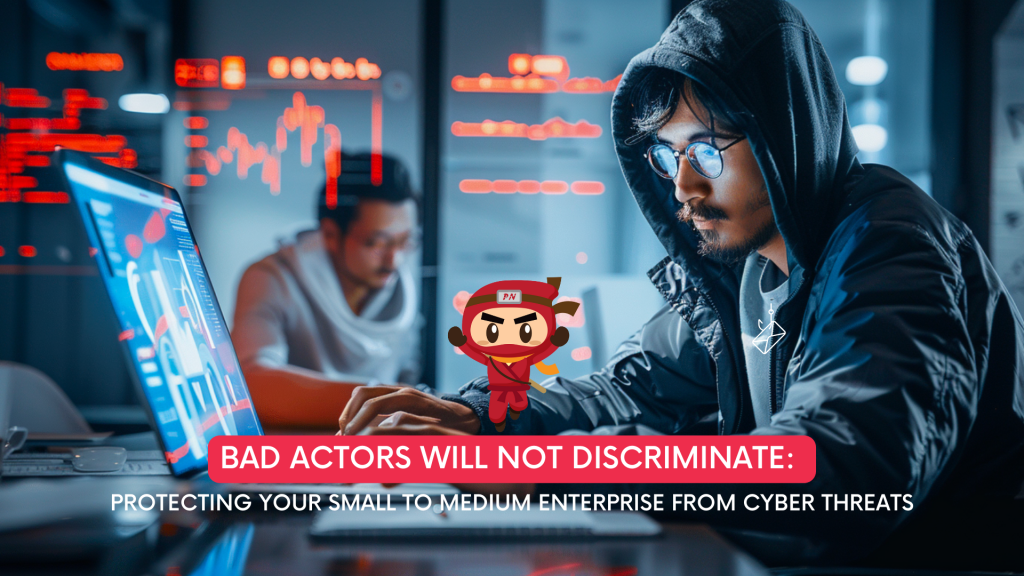KEEP IN TOUCH
Subscribe to our mailing list to get free tips on Data Protection and Cybersecurity updates weekly!







Cybercriminals, often referred to as “bad actors,” do not discriminate based on the size of an organization. Whether you are a small business or a medium enterprise, if there’s an opportunity to exploit, bad actors will target you. This article explores the reasons why all businesses are at risk and provides strategies to protect your enterprise from cyber threats.
Cyber threats are evolving at an alarming rate, and bad actors are becoming increasingly sophisticated. While large corporations often make headlines when they are breached, small to medium enterprises (SMEs) are frequently targeted as well. In fact, SMEs can be more appealing targets because they often have fewer resources dedicated to cybersecurity, making them easier to exploit.
Bad actors target SMEs for several reasons:
Understanding the common cyber threats can help SMEs better prepare and defend against them. Here are some prevalent threats:
Threat: Phishing emails are designed to trick employees into revealing sensitive information or downloading malware. These emails often appear to come from legitimate sources.
How to Defend: Educate employees about the signs of phishing emails and implement email filtering solutions to detect and block malicious emails.
Threat: Ransomware encrypts a company’s data, rendering it inaccessible until a ransom is paid. These attacks can cripple an organization’s operations.
How to Defend: Regularly back up data and ensure backups are stored securely and offline. Implement security measures to detect and prevent ransomware infections.
Threat: Malware, including viruses, trojans, and spyware, can be used to steal data, disrupt operations, or gain unauthorized access to systems.
How to Defend: Use antivirus and anti-malware software and keep it updated. Educate employees about the risks of downloading and installing unverified software.
Threat: BEC involves cybercriminals impersonating executives or business partners to request financial transactions or sensitive information.
How to Defend: Implement verification protocols for financial transactions and sensitive requests. Verify the legitimacy of such requests by contacting the supposed sender directly.

While the threat landscape is daunting, there are effective strategies SMEs can implement to protect themselves:
Strategy: Regularly train employees on cybersecurity best practices, including recognizing phishing attempts, safe browsing habits, and the importance of strong passwords.
Implementation: Conduct regular cybersecurity training sessions and send out reminders about best practices. Simulate phishing attacks to test and reinforce employee awareness.
Strategy: Develop and enforce comprehensive security policies that cover data protection, password management, and acceptable use of company resources.
Implementation: Create clear policies and ensure all employees understand and adhere to them. Regularly review and update these policies to address new threats.
Strategy: Implement advanced security solutions, such as firewalls, intrusion detection systems, and endpoint protection, to defend against cyber threats.
Implementation: Invest in reliable security software and hardware. Ensure these solutions are properly configured and regularly updated to address new vulnerabilities.
Strategy: Encrypt sensitive data to protect it from unauthorized access, both in transit and at rest.
Implementation: Use encryption tools to secure sensitive data. Ensure encryption keys are stored securely and managed properly.
Strategy: Regularly back up critical data to protect against data loss from ransomware or other cyber incidents.
Implementation: Schedule regular backups and store them in a secure, offline location. Test backups periodically to ensure they can be restored successfully.
Strategy: Implement strict access controls to limit who can access sensitive information and systems.
Implementation: Use role-based access controls (RBAC) to grant employees access only to the information and systems they need for their job. Regularly review access permissions and revoke unnecessary access.
Strategy: Develop an incident response plan to quickly and effectively respond to cyber incidents.
Implementation: Create a detailed incident response plan that outlines the steps to take in the event of a cyberattack. Conduct regular drills to ensure employees know their roles and responsibilities.

Cyber insurance can provide a financial safety net in the event of a cyberattack. It can cover costs associated with data breaches, ransomware attacks, and other cyber incidents, including legal fees, notification costs, and business interruption losses. While cyber insurance does not replace the need for robust cybersecurity measures, it can help mitigate the financial impact of a cyberattack.
Bad actors will not discriminate when it comes to targeting businesses. Whether you are a small business or a medium enterprise, it is crucial to recognize the risk and take proactive steps to protect your organization. By understanding common cyber threats, educating employees, implementing robust security measures, and developing a strong incident response plan, you can significantly reduce your vulnerability to cyberattacks. Remember, cybersecurity is not a one-time effort but an ongoing process that requires vigilance and adaptation to the ever-evolving threat landscape. Protect your SME today to ensure a secure and resilient future.
Your appointed DPO can work with you on your PDPA compliance, ensuring that there will be policies in place to make sure that the handling of personal data is PDPA compliant.
A Data Protection Officer (DPO) oversees data protection responsibilities and ensures that organisations comply with the Personal Data Protection Act (PDPA). Furthermore, every Organisation’s DPO should be able to curb any instances of PDPA noncompliance as it is the officer responsible for maintaining the positive posture of an organisation’s cybersecurity.
DPOs complement organisations’ efforts to ensure that the organisation’s methods of collecting personal data comply with the PDPA. It also ensures that policies are set in place to make sure that there will be no instances of data breaches in the future.
Don’t wait any longer to ensure your organisation is PDPA compliant. Take our free 3-minute PDPA Compliance Self-audit checklist now, the same “secret weapon” used by our clients to keep them on track. Upon completion, we will send you the results so you can take the necessary action to protect your customers’ data. Complete the free assessment checklist today and take the first step towards protecting your customers’ personal data.